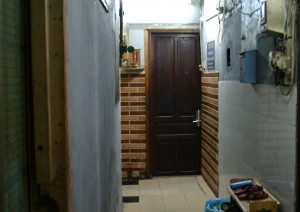
The former hotel at 1 Nguyễn Trung Trực (rue Filippini) where the Annam Communist Party was set up in October 1929
This article was published previously in Saigoneer http://saigoneer.com
It’s often assumed that it’s only Hồ Chí Minh City’s colonial-era heritage buildings which are under threat. But in recent years, several important revolutionary monuments have also been lost.
According to the 1998 book Historic and Cultural Vestiges of Hồ Chí Minh City (Di Tích Lịch Sử-Văn Hóa Thành Phố Hồ Chí Minh, Nhà Xuất Bản Trẻ), in June 1928, members of the Việt Nam Revolutionary Youth League (Việt Nam Thanh niên Cách mạng Đồng chí hội) met in room 5 on the second floor of the Tân Hòa Hotel at 88 boulevard Bonard (Lê Lợi), Saigon, to establish the League’s Cochinchina regional committee.

The entrance to the second floor room at 88 Lê Lợi (boulevard Bonard), now a private apartment, where the Việt Nam Revolutionary Youth League’s Cochinchina regional committee was set up in June 1928
Founded in Guangzhou by Hồ Chí Minh in 1925, the League subsequently embarked on a vigorous propaganda drive, recruiting many new members throughout the country. The establishment of three regional committees (Cochinchina, Annam, Tonkin) enabled it to further expand its activities. Phan Trọng Bình served as secretary of the Cochinchina regional committee until March 1929, when he was succeeded by Phạm Văn Đồng, who in the 1960s would become Prime Minister of Việt Nam.
Because of its historical significance, the former hotel room at 88 Lê Lợi was declared a historic monument by the Ministry of Culture and Information on 16 November 1988 (decision 1288-VH/QĐ). However, the second floor of 88 Lê Lợi is currently rented out as private apartments and there is nothing to suggest that any historic events took place here.
The same book also lists another revolutionary monument, situated less than 100m from 88 Lê Lợi. Following the May 1929 congress in Hong Kong, Việt Nam Revolutionary Youth League delegates from Tonkin (northern Việt Nam) returned to Hà Nội to found the Indochina Communist Party (Đông Dương Cộng sản Đảng). Delegates from Cochinchina subsequently followed suit – in late July or early August 1929, Châu Văn Liêm, Hồ Tùng Mậu, Lê Hồng Sơn, Lê Duy Điếm and several other members of the League met at Liêm’s house on rue Hamelin (Lê Thị Hồng Gấm) in Saigon and resolved to set up the Annam Communist Party (An Nam Cộng Sản Ðảng). This organisation was formally established in October 1929 at a meeting in room 1 on the second floor of a hotel (believed to have been known in French as the Hôtel de l’Ouest) at 1 rue Filippini (Nguyễn Trung Trực). Attended by around 30 delegates, the meeting set up a provisional party executive committee and appointed Châu Văn Liêm as secretary.

Room 1 at 1 Nguyễn Trung Trực (rue Filippini), where the Annam Communist Party was founded in October 1929, is now also a private apartment
While the Annam Communist Party was a short-lived organisation – in February 1930 it was merged with the Indochina Communist Party to form the Communist Party of Việt Nam – it is said to have played an important role in the Vietnamese revolution and for that reason, the place where it was founded – room 1 at 1 Nguyễn Trung Trực – was also declared a historic monument by the Ministry of Culture and Information on 16 November 1988. However, as with 88 Lê Lợi, the site is now an unmarked private apartment.
Where 88 Lê Lợi and 1 Nguyễn Trung Trực are concerned, it can at least be said that the original buildings still exist. But another registered historic site in Hồ Chí Minh City’s District 1, the former headquarters of the Dân Chúng newspaper at 43 rue Hamelin (Lê Thị Hồng Gấm), has been completely lost to redevelopment.
The 1998 book explains how the Vietnamese-language revolutionary newspaper Dân Chúng and its French-language counterpart Le Peuple were founded on 22 July 1938 and 7 September 1939 respectively, during the brief period of relatively liberal colonial policy which followed the accession to power of Léon Blum’s left-wing Popular Front party in France.

A modern six-storey building now stands on the site of the former Dân Chúng newspaper office at 43 Lê Thị Hồng Gấm (rue Hamelin)
The office at 43 rue Hamelin (Lê Thị Hồng Gấm) where these newspapers were produced is described in Historic and Cultural Vestiges of Hồ Chí Minh City as “a single-storey brick building, 8m wide by 23.6m deep, with a traditional yin-yang tiled roof and a tiled floor.” It, too, was registered as a historic monument by the Ministry of Culture and Information on 16 November 1988. However, soon after the book was published, the building found its way into private hands. Despite its heritage status, it was demolished in 2010 to make way for a new six-storey structure.
The demise of these revolutionary monuments has not gone unnoticed in the local press. In 2011, the Sài Gòn Giải Phóng newspaper ran an article entitled “City relics of historical importance in dismal conditions,” which highlighted the plight of these and several other registered historic monuments in Hồ Chí Minh City.
Tim Doling is the author of the guidebook Exploring Saigon-Chợ Lớn – Vanishing heritage of Hồ Chí Minh City (Nhà Xuất Bản Thế Giới, Hà Nội, 2019)
A full index of all Tim’s blog articles since November 2013 is now available here.
Join the Facebook group pages Saigon-Chợ Lớn Then & Now to see historic photographs juxtaposed with new ones taken in the same locations, and Đài Quan sát Di sản Sài Gòn – Saigon Heritage Observatory for up-to-date information on conservation issues in Saigon and Chợ Lớn.

